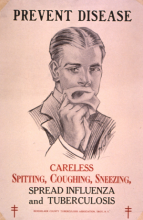Article
Also referred to as "TB," tuberculosis is a highly infectious bacterial disease that affects the lungs by forming nodules and breaking down blood vessels. As the disease progresses and lung capacity, or the ability to breath, worsens, a patient with TB essentially begins to drown in the fluids building up in his or her lungs. Tuberculosis is caused by Mycobacterium tuberculosis, a bacterium that is resistant to mild antibiotics. Tuberculosis is spread from person to person through the air. In areas with poor hygiene and limited healthcare, this disease can proliferate to epidemic proportions.
"Tuberculosis Prevention Poster" by Rensselaer County Tuberculosis Association. - U.S. National Library of Medicine is licensed under Public Domain.
Manuscripts
References
Centers for Disease Control
N.d. Tuberculosis education core curriculum.
http://www.cdc.gov/tb/education/corecurr/pdf/chapter2.pdf, accessed March 15, 2016.
Encyclopædia Britannica Online
N.d. tuberculosis (TB).
http://www.britannica.com/EBchecked/topic/608235/tuberculosis-TB
accessed October 16, 2014.

